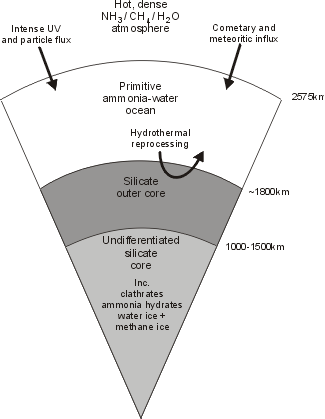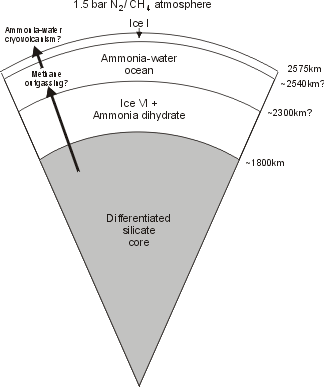Might Titan have ever had liquid water?
 Early History of Titan
Early History of Titan
Recall the early history of the terrestrial planets:
significant heating from heavy bombardments. The
internal structure of Titan at the close of the
accretion phase, about 3.5-4 billion years ago is
shown to the right. Energy sources in the early ocean
include kinetic energy from meteorites and comets.
During this time, the ocean was exposed at the surface
creating a warm (»300K) aqueous environment with
abundant energy sources. This is the closest Titan is
ever likely to have come to the primitive terrestrial
environment in which life is thought to have formed
on Earth.
Titanian microbes, in the absence of free oxygen are likely
to have developed as anaerobes. Given also the low sunlight
levels at Saturn's distance from the Sun potential
micro-organisms are unlikely to have been dependent on
sunlight for energy. They would likely have been chemosynthetic
autrotrophs as the ocean was soon roofed over by a layer of ice.
and the crust acquiring a thickness of ~30km after approximately
70 million years.

What about Sub-Surface liquid water?
It has been shown that if an ocean
was present following accretion then an ocean is almost
certainly present today, deep beneath the icey crust. Based on
heatflow estimates and the viscosity of the ice crust,
scientists estimate there to be a contemporary ocean of
liquid water and ammonia with a depth of about 200 km.
Tests for the presence of a subsurface ocean
A liquid layer in Titan's interior reduces the overall rigidity
of the moon. The Cassini mission to Saturn will yield, in the
course of numerous flybys, a sensitive measure of the
gravitational rigidity of Titan. Also, a complex magnetic
field signature, induced by a conductive liquid shell, might
also be used to infer a liquid layer.
 Early History of Titan
Early History of Titan